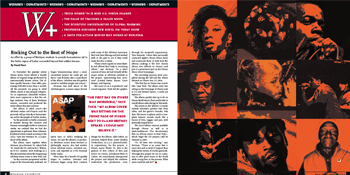Rocking Out to the Beat of Hope
 In November the popular online iTunes Music Store offered a benefit album of original songs performed by internationally known artists. The album quickly became a best seller, generating $100,000 in less than a month. All the proceeds are going to relief efforts aimed at war-ravaged refugees. It’s an impressive, admirable venture. Even more impressive is that five college students, four of them Wesleyan seniors, conceived and produced the entire album this past summer.
In November the popular online iTunes Music Store offered a benefit album of original songs performed by internationally known artists. The album quickly became a best seller, generating $100,000 in less than a month. All the proceeds are going to relief efforts aimed at war-ravaged refugees. It’s an impressive, admirable venture. Even more impressive is that five college students, four of them Wesleyan seniors, conceived and produced the entire album this past summer.
The album is titled ASAP?the Afrobeat Sudan Aid Project?and the proceeds will go directly to humanitarian aid for the people of Darfur, Sudan.
“As the genocide in Darfur continued to escalate during the summer and became increasingly visible in American media, we realized that we had the opportunity to galvanize these inherently political artists toward assisting in the crisis,” says Eric Herman ’05, a co-producer of the album.
The album came together when Herman, Jesse Brenner ’05, Adam Tuck ’05, David Ahl ’05, and Joe M.F. Wilson, an N.Y.U. student, were working on a film documentary about the burgeoning Afrobeat music scene in New York City.
“As the summer progressed and the scope of the documentary widened, we began brainstorming about a more immediate project we could get out there,” says Brenner, also a co-producer of the album. “Afrobeat was the perfect sound to mobilize people into action.”
Herman was well aware of the Afrobeat genre. A music major, he had spent time in Africa studying the music. He and the album’s co-producer, Wesleyan senior Jesse Brenner (a philosophy major), also had written about Afrobeat music, reviewed concerts, and reported on it for National Public Radio.
Their ideas for a benefit CD quickly began to coalesce. Herman and Brenner began using their contacts with some of the Afrobeat musicians they had been filming and had worked with in the past to see if they could make the disc a reality.
“Those artists signed on immediately and offered their help in recruiting others,” says Herman. “In a short amount of time, we had virtually all the major artists in Afrobeat involved in the project, representing four countries” (United States, France, Great Britain, and Nigeria).
Ahl came on as a co-producer and sound engineer. Tuck did the graphic design for the album. Ahl’s father, an attorney, helped them create Modiba Productions, an L.L.C. (limited liability corporation), for the project. A friend, Aaron Thaler ’05, who is the godson of Ben Cohen of Ben and Jerry’s Ice Cream, introduced them to Cohen. He immediately championed the project and helped the students underwrite the production costs through his nonprofit organization, True Majority. Cohen then personally contacted Apple’s iTunes Music Store and convinced them to both host the album?making it the first charity album ever offered on iTunes?and give it a prominent spot on the iTunes Music Store homepage.
The recording sessions were completed during the fall and the album debuted on iTunes Nov. 23, 2004.
“The first day on iTunes was incredible,” says Tuck. “My album cover was sitting on the front page of iTunes next to U2 and Britney Spears. I could not believe it.”
The album quickly shot up to #1 on iTunes World Music Chart and hit #26 in overall album sales during its first week.
The artists on the album’s 12 tracks include Afrobeat’s greatest star, Tony Allen, and the genre’s founder, Fela Kuti. The music is upbeat, and to a neophyte listener sounds much like a fusion of SKA, reggae, and jazz, with politically-tinged lyrics.
The ASAP album remains available through iTunes, as well as at www.modiba.net. The documentary film on African music in New York? which begat the CD project?will be released in 2005.
“It’s all been very exciting,” says Herman. “There is no cause that is more dire and in need of support than helping the victims of Darfur genocide. Through this project we are in a position to offer great music to the world while saving lives in the process. What more could we ask for?”
Download a PDF of the complete article HERE
